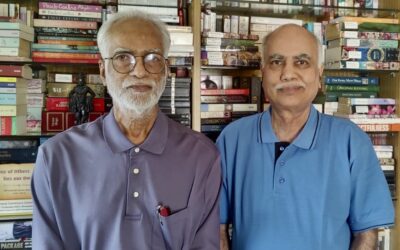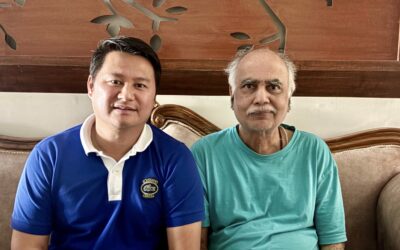Two people played a crucial role in my professional life—Dr APJ Abdul Kalam, under whom I worked first from 1982 at the Defence Research and Development Organization (DRDO) and later as his pupil till he departed in 2015, and Dr B Soma Raju, Cardiologist…

Spiritual Turnpikes
Spiritual Turnpikes
I recently met Mr. Chandu Thota, Vice President at Google, when he was here in Hyderabad, where he studied at Osmania Engineering College. Chandu played a pioneering role in the development of digital mapping. He worked at Microsoft from 2002 to 2007 on maps and later established his own company Dealmap, which was acquired by Google in 2011. Since then, Chandu has been at Google.
Born and brought up in coastal Andhra Pradesh, Chandu comes from a traditional family where dogmas and rituals are integral parts of life. While we were discussing how the modern generation is becoming superficial about religion and lacks conviction about timeless traditional wisdom, Chandu brought up the example of a map. Moving a stylus from one place to another is so easy on a map. Thousands of miles can be crossed–oceans, mountains, and deserts—in a moment—without even getting up from your chair. Even the thrill of going to faraway locations can be felt, if only on a map.
So, this is exactly what is happening with the younger generation in the realm of religion. When we spend hours discussing scriptures, theories, enlightenment, and spiritual gurus and their miracles—the Internet is flooded with them—we may not realize it, but it is just like moving the stylus on the map. The confidence with which “gurus” narrate morally superior concepts often deludes the “chelas” into thinking that they have arrived, even though none of them have even started.
Tokenism is the trend. Wearing a mala, tying a thread on the wrist, and even applying a tilak, can never make a difference unless it represents a change in attitude. But merely done as a fashion, this comforting illusion of having “arrived” bleeds out the reasons, motivation, and energy from our ambition to undertake the journey. Some of us may get addicted to the “high” we get from moving the stylus on the map and consequently fritter away a significant part of our lives doing just that—and many may never undertake the actual journey. Chandu casually called it “spiritual turnpikes” but it drove me into reflection and to write this blog.
I was introduced to the word “Turnpike” by Bhooshan Sawant. He lives in North Brunswick, New Jersey. In 2011, I spent a week at his home. Many times, he drove me to New York City and took a toll road to bypass the perennial traffic on the Garden State Parkway. Bhooshan told me that the Turnpike originated in Britain during the 18th and 19th centuries when the Parliament allowed the formation of Turnpike trusts to build roads and bridges and collect tolls from the users. Basically, the turnpike is the horizontal bar lowered to block your way and lifted when the tax is paid.
This later became a practice for the governments to collect taxes from travellers and in India, almost all new roads are created as turnpikes. Similarly, spirituality is taken over by religion and we are conditioned to believe that one must follow some religion to attain spiritual enlightenment. There are organized events, “paid” services, ritualistic performances, and obnoxiously collected subscription models selling spirituality. This is on the supply side. Even more problematic is the demand side.
Hordes of young people are turning into spiritual addicts. Like parrots, they talk indefatigably about how yogis can leave their physical bodies and travel to distant planets or what happens after death. They perceive themselves as spiritually evolved people but their behaviors could not be further off. They are arrogant, absent-minded, irresponsible, undisciplined, and unethical. No wonder the roads are full of rage and people in crowds and on social media are impolite and rude.
What is spirituality? Understanding the basic fact that we are an immortal spirit living in “this body” that grows, decays and eventually dies, is spirituality. The purpose of life is the evolution of this spirit, which means sorting out the bad embedded in us, like dust on a mirror. Each one of us has our demons, the shadow selves. The art of living is about going by our values and bravely confronting these shadows; acknowledging, feeling, and transcending our inconvenient emotions.
All this holds a purpose. By discarding all that is not good, building mutually empathetic and rewarding relationships; resolving problems; and shouldering our responsibilities we not only lead a good life but also create conditions where others can better theirs. However, most of us unconsciously use religion and rituals to distract ourselves from the feelings of guilt, frustration, and inadequacy we do not want to experience, the responsibilities of life we do not want to bear, and the hard work required to resolve the issues we want to escape from.
We pick up phrases like, “Life is suffering”; “Suffering is the nectar that cleanses the soul”; “God tests and strengthens our faith through suffering,” and so on. These are in essence our vain attempts to avoid facing the mirror – to see our faults and fix them. It is a pity and a waste of human life to miss the chance of expanding consciousness and using it to create sensory pleasures and conveniences – no less ludicrous than an astronaut riding a horse.
My 33 years of tutelage under Dr APJ Abdul Kalam helped me immensely to discern between religion and spirituality. Not that they are exclusive but that they are different and must be understood and practised that way. Armed with this awareness, I keep coming across people who are not seeking but escaping their true selves, and I could recognize myself as one of them, and see this game of using spiritual discussions and practices as a substitute for our transformation instead of a means to support it.
During my first visit to San Francisco with Dr Kalam in 2007, after he relinquished the presidency, I was given a book by John Welwood entitled, Perfect Love, Imperfect Relationships, published at that time. Buddhist teacher and psychotherapist, Welwood coined the term “Spiritual Bypassing” in the early 1980s and I enjoyed discussing it with Dr Kalam on our flight back home. The tendency to use spiritual ideas, discussions, and practices to sidestep or avoid facing unresolved emotional issues, psychological wounds, and unfinished developmental tasks has always been there. Welwood articulated it well now using the familiar term “bypassing.”
The spiritual journey begins with the realisation that our reality is the immortal spirit present inside our body and not the body itself. It is like “grounding” to our basic existential fact. Opposite to adorning artefacts – lockets, bracelets, particular dresses – and undertaking retreats, pilgrimages, and attending congregations we can brag about, discovering who we are at our deepest core is a very quiet affair.
It is a process of gradually removing “onion-like” layers of anything that is neither factually true nor who we are at our core in order to inch closer to the truth or our true selves. Being cognizant of our haughtiness ought to humble us a little, but if we act as though we are pursuing and carrying out all righteous deeds, we are subconsciously creating an alibi to do what is not right. In addition, there are no speed breakers on this slick slope. In the shadow of the light we believe we are heading towards, it is hard to perceive or assess how much misery we might be causing to ourselves and others once we start to believe we are holy, pure, and one with God, and therefore already nearly flawless. Dr Kalam used to caution me before planning out a project that man is indeed a formidable rationalizing machine capable of making even the most irrational things accepted.
MORE FROM THE BLOG
Is Life a Game?
Will 2025 be ‘Year One’ of the New World?
Certain words and phrases gain prominence at different times, and this is becoming a fashion in the Internet media world. “Deep State is currently circulating about the mysterious powers that run the world…
Knowledge comes from Within
David Deutsch (b. 1953), a British physicist at the University of Oxford, is among the world’s foremost philosopher-scientists alive. He has worked on fundamental issues in physics, particularly quantum computing, quantum information and constructor theory. I learned about him through his books…








